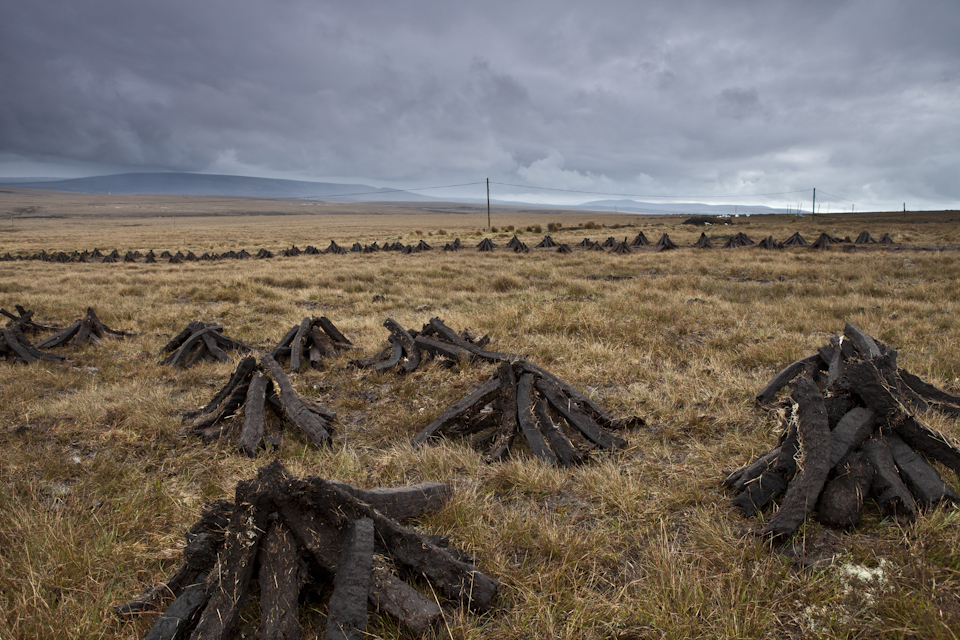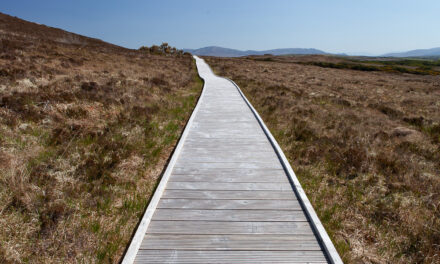Seamus Heaney, has joined the ranks of Irish literary greats, as he was finally laid to rest on this September day near the place of his birth in County Derry, Northern Ireland. Perhaps to join his Bog Queen preserved for eternity in both peat and words –
“I lay waiting / between turf-face and demesne wall, / between heathery levels / and glass-toothed stone” (Taken from ‘The Bog Queen’).
The former Nobel Laureate is returning to the very land that he so powerfully portrayed through his poetry. It is certainly not difficult for an Irishman to identify with Heaney’s treatment of the bog as a means to make sense of events unfolding around him, and as a prompt for a subtle yet powerful form of social commentary. Ireland’s bogland has long been exploited for turf as a fuel to warm homes through the long winter. Its rich and evocative imagery has also been employed in the service of one of the greatest poets of modern times. Indeed the very sound of ‘the squelch and slap / Of soggy peat’ has a power that transports the reader to a boggy land. Now that same peat is fuelling the resentment of rural folk who never gained in the ‘Celtic Tiger’ years of prosperity, and yet are still expected to shoulder the burden of austerity.
So why is the protection of Ireland’s bogland so important?
An estimated 16% of the surface area of Ireland is under peat. The Irish Peatland Conservation Council (IPCC) estimates that only 8% of our raised bogs have any remaining conservation value. The industrialization of peat extraction (not to be confused with more sustainable cutting methods) from the 1950’s by Bord na Mona laid waste to large swathes of bogland that are clearly visible in satellite images, such as those shown on Google Maps. Many bogs are so badly damaged that continued turf-cutting on a small-scale is no longer an issue. However this makes the few remaining areas that are relatively intact all the more valuable.
Ireland has a significant proportion of the few surviving remnants of raised bog within Europe. 139 raised bogs have been designated for protection in 53 Special Areas of Conservation (SACs) under the EU Habitats Directive and 75 Natural Heritage Areas (NHAs) under the Wildlife Act of 2000. Although the turf-cutters are being offered alternative sites or monetary compensation, the EU Directive still serves to stoke consternation amongst otherwise fuel-impoverished households. The currently protected sites represent only 20% of the original raised bog in the country. “In Mayo, there’s been almost 100% compliance and generally on the ground people are happy to either take compensation or go with the option for relocation”, Sue Callaghan, District Conservation Officer in Mayo for the National Parks and Wildlife Service (NPWS) noted in a recent interview with Climate Change Cafe. But this is certainly not the case in other parts of the country such as Galway and Roscommon. And the vast majority of bog in my home county of Mayo is blanket bog meaning that this land is currently not protected in the same way. The small island of Ireland possesses a staggering 8% of the world’s blanket bog and is the most important country in Europe for this type of habitat. This underlines the need to protect not only our intact raised bogs but also the blanket bogs along Ireland’s Atlantic coast.
The NPWS website describes the loss of Ireland’s bogs as “an irreplaceable loss to global biodiversity”. Apart from providing unique habitat to native flora and fauna, bogland also contributes a range of valuable ecosystem services that are taken for granted by most of us. Excess CO2 from the atmosphere is removed and locked within the peat in the ground which helps to combat manmade climate change. Bogland also provides clean water and reduces flooding due to its capacity to absorb, hold and slowly release water. From the point of view of the turf-cutter, the bog is a vital source of fuel for heating and cooking in many rural households through the long winter months.
Turf wars – what’s it all about?
Ostensibly, the ‘turf-war’ is a case of standing up for the right to harvest the land as your father and forefathers have done before you. Heaney draws upon the land as central to understanding the nation as a whole, and in particular its people. He pays homage to his father and to the tradition of harvesting the turf in the poem ‘Digging’ –
Nicking and slicing neatly, heaving sods / Over his shoulder, going down and down / For the good turf. Digging.
But the ban on turf-cutting in certain parts of rural Ireland has become a means to vent anger and frustration at a far wider sense of marginalization and betrayal. It is a rallying point for any number of people disenfranchised and distrustful of big government and who do not feel fairly consulted or adequately represented. Memories of the struggle for the land lasts long in the minds of rural Irish communities. This goes back to the late 19th Century (and long before), when the Irish Land League was formed in Castlebar, County Mayo by Charles Steward Parnell and Michael Davitt amongst others. The Land League campaigned for an end to landlordism and the unfair eviction of tenants by rallying around the Three ‘F’s (Fair Rent, Fixity of Tenure and Free Sale). As recently as one week ago, the Irish Independent reported the cutting of turf on a protected site in County Kerry in defiance of the ban (Turf protestors take another cut at EU ban). It’s also worth pointing out that the stance taken by the Irish media has largely been sympathetic to their cause.
Groups such as ‘Support the Turf-cutters’ and the Turf Cutters and Contractors Association are unsurprisingly using social media as a means to galvanize support. Their success relies upon making this a highly emotive issue, of creating a sense of injustice and outrage that forces people to take sides. Even Heaney struggles with a sense of indignation and a need to speak out against clannish or sectarian behavior –
Who would connive / in civilized outrage / yet understand the exact / and tribal, intimate revenge (Taken from ‘Punishment’)
All the resentment against the excesses of corrupt politicians, bankers and developers is perfectly understandable and largely justified but should not be rolled into an issue that has very little to do with these same forces. A more balanced, calm and rational approach will serve everyone’s interests far better in the long run. Heaney used the bogland and the ancient bog bodies preserved in its peat as way of promoting peace and understanding amongst the religious strife permeating Northern Ireland. He describes the unearthing of a bog man as a gentle act –
Those dark juices working / Him to a saint’s kept body / Trove of the turf-cutters’ / Honeycombed workings (Taken from ‘The Tollund Man’)
Let us, the turf-cutters and people of Ireland take note. It is a privilege and not a right to mine the land for our own sustenance.
Is there not a case to protect our landscape?
Although Heaney’s bogland poems did not employ words primarily in the service of protecting and conserving natural landscape, his rhyme and reason has undoubtedly influenced the political landscape of Northern Ireland. Heaney seeks inspiration from the bog to cut through the many layers of history and complexity that underline the so-called ‘Troubles’ in Northern Ireland, which he grew up around. He describes savagery in the death, rediscovery and redemption of an ancient people preserved for millennia in the water-logged bogland –
The plait of my hair / a slimy birth-cord / of bog, had been cut / and I rose from the dark (Taken from ‘The Bog Queen’)
He excavates the truth from the deep peat –
Every layer they strip / Seems camped on before (Taken from ‘Bogland’)
to expose both violence,
The chin is a visor / raised above the vent / of his slashed throat (Taken from ‘The Grauballe Man’)
and an undeniable anguish,
As if he had been poured in tar, he lies on a pillow of turf and seems to weep the black river of himself (Taken from ‘The Grauballe Man’).
The great poet mines the land for words, harvesting it for symbols that can be used to construct a narrative around the strife in his native country.
As a photographer, I try to use another form of art to convey the beauty of the landscape through visual imagery in the face of increasing pressures to exploit the land. Heaney doesn’t preoccupy himself with any such nostalgia for the land in his bogland poems although there are moments when his respect clearly shines through –
The ground itself is kind, black butter / Melting and opening underfoot / Missing its last definition / By millions of years (Taken from ‘Bogland’)
And his words can be poignant when he chooses –
We have no prairies / To slice a big sun at evening / Everywhere the eye concedes to / Encrouching horizon / Is wooed into the Cyclops’ eye/ Of a tarn. (Taken from ‘Bogland’)
As I read these words, I imagine a wide bogscape, framed by mountains and lake but also surrounded by manmade elements that trespass on the wild landscape, imposing themselves.
A need to focus on the real debate
Ireland signed up to the EU Habitats Directive in 1999 but managed to get a 10-year deferral as a special case, meaning that the legislation only became law between 2009 and 2013 (depending on the bogs’ location). The turf-cutters were told that they would be offered alternative sites or equivalent compensation in exchange for giving up the right to cut on protected bog. This sounds like a reasonable offer but the government minister at the time (Sile de Valera) did not consult the people affected and this has understandably bred anger and resentment to this day. The turf-cutters feel victimized, whether justified or not. They read about corrupt property developers and greedy bankers who are escaping justice and all the while the ordinary man on the street is being punished by increasing taxes, property and water rates, and unemployment. And so the kernel of the whole debate has moved a long way from its core objective, which is to protect the rich cultural, environmental and natural heritage that Ireland enjoys.
Furthermore, there has been a failure of the National Parks and Wildlife Service (NPWS), who monitor and enforce the EU Directive and Wildlife Act, to live up to their roles and responsibilities. The IPCC commented that “they [NPWS] have shown very little leadership in the peatland areas affected which has given the Turf Cutters and Contractors Association lots of space to scaremonger the individual turf cutters involved.” This was confirmed by Ms. Callaghan who admitted that, “certainly there should be more communication by NPWS with people on the ground and that was a mistake that was made in the past. I think that’s recognized by everybody. And unfortunately with NPWS, there’s lack of staff resources, lack of so many resources that hasn’t made it possible”. I also got a sense of defeatism and powerlessness when asking how she would explain to a landowner that we need to protect certain bogland. “It’s a difficult one and I wouldn’t even hesitate or wouldn’t contemplate trying to persuade somebody whose land is designated…”, came the unexpected reply.
The present day government is mindful of the huge sacrifices it has imposed on the Irish people in these times of austerity and doesn’t want to fan the flames any further by tackling a highly emotive issue that is being portrayed by a few as some kind of ‘Last Stand at the Alamo’. The entire debate has to be reframed so that a small minority of turf-cutters cannot hijack the wider issue by portraying this as simply a struggle for land rights. There is a pressing need to untwine cultural heritage from natural heritage, to understand that both can co-exist. For its part, the Irish government needs to consider a more generous compensation scheme for turf-cutters and a far more inclusive approach that is less authoritarian and more mindful of rural communities. It needs to show respect for their concerns about threats to loss of tradition and livelihood, not by standing back and failing to enforce its own legal duties but by making a strong case for the moral obligation to respect the natural heritage that we have inherited. The law should be enforced not because the EU told us that we have to do this. We should be compelled out of a sense of responsibility to the land that our forefathers fought to reclaim in British colonial times.
Final thoughts
We are not only turf-cutters and farmers and landowners; we are an Irish people who are defined by a common language, history and tradition. But I feel that our sense of Irishness goes far beyond this. Our very identity is tied up in the land, in the wild landscape along the Atlantic Coast and the patchwork of emerald fields and rust-coloured peatlands found the length and breath of the country. We are the land and the land is us. If we lose the distinctive character of the Irish landscape, its habitats and native species, then we lose ourselves to misdirected anger; we forsake our sense of respect for the land, and for ourselves.
Heaney was no turf-cutter and neither am I. And yet the rich descriptive language of his bogland poems have immortalized this very Irish landscape. His words use the bogland as a metaphor to make sense of the troubles and strife in our land. Who of us truly desires to destroy our natural heritage and landscape and in the process, lose the sense of ourselves? Instead, let us continue to draw upon the bog for inspiration to convey our sense of who we are and our struggle to exist in peace and harmony with our neighbours.
Between my finger and my thumb / The squat pen rests. / I’ll dig with it (Last words taken from ‘Bogland’).
Originally published in 2013






Recent Comments